What is AI In Inventory Management? Overview 2025
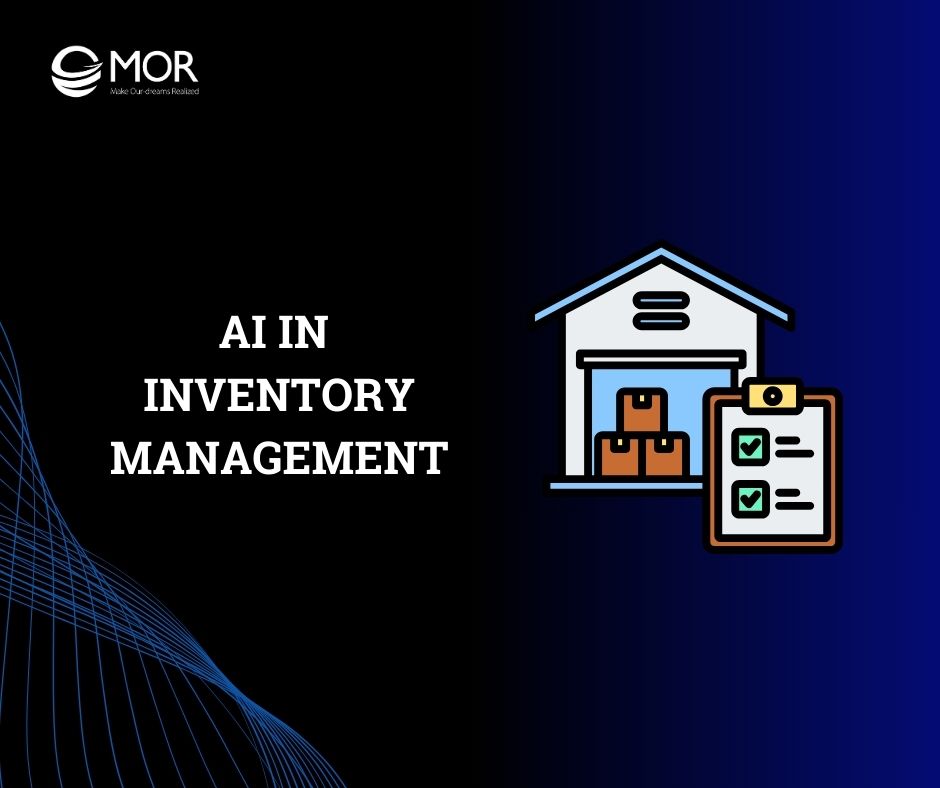
Has your business ever wondered how to optimize warehouse operations and reduce inventory costs? Implementing AI in inventory management is not just a trend but a strategic necessity to enhance supply chain efficiency. In this article, MOR Software will provide insights, best practices, and real-world applications to help your business unlock the full potential of AI in inventory management.
What Is AI Inventory Management?
AI in inventory management is the practice of using artificial intelligence technologies to optimize the inventory management process. Instead of relying on traditional methods, machine learning enables businesses to analyze data from multiple sources, including ERP, WMS, POS, e-commerce platforms, warehouse logs, and transportation data.
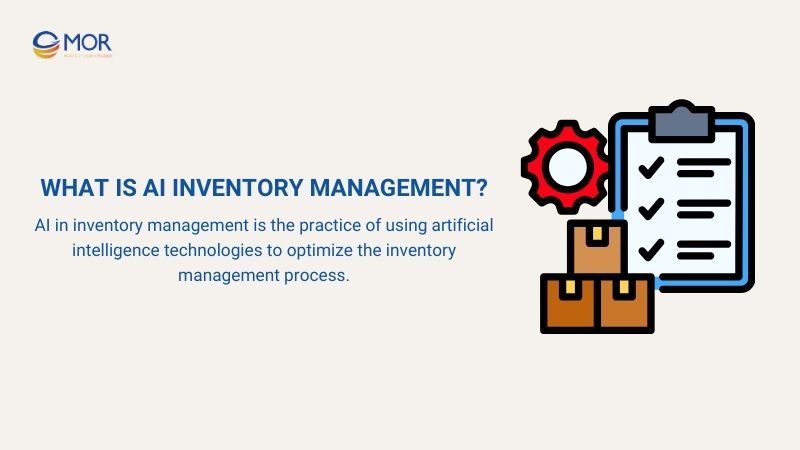
The use of AI-driven replenishment solutions allows automated purchase order creation and dynamic stock level adjustments based on real-time demand. At the same time, AI in distribution helps businesses optimize product flow between warehouses, logistics centers, and retail locations, ensuring that products are always available in the right place at the right time.
How Does AI in Inventory Management Work?
AI in inventory management works by collecting and analyzing data from multiple internal sources. Below is a detailed overview of all the processes you need to understand.
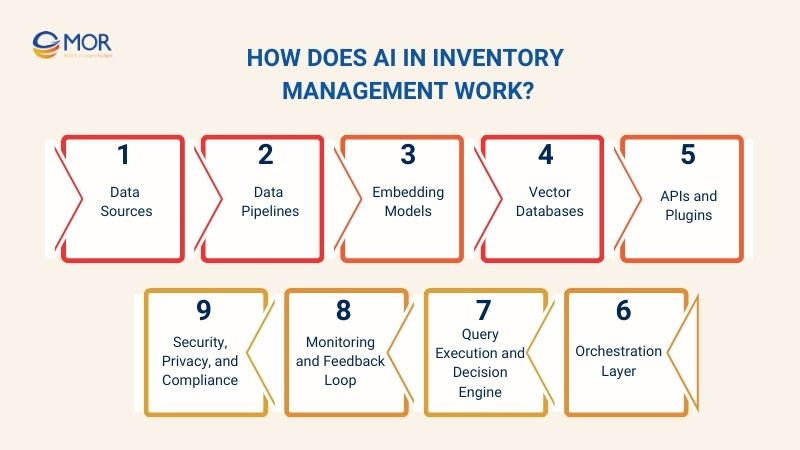
Data Sources
In AI in inventory management, collecting detailed and accurate data is the foundation for effective forecasting and decision-making. Internal data sources include ERP, WMS, POS, AI tools for ecommerce, warehouse logs, and transportation data.
External data sources such as weather, holidays, special events, supplier performance, and market signals help AI adjust forecasts and plan replenishment according to real-world fluctuations. For instance, holiday seasons can increase demand for certain products, while supplier performance data helps predict delivery delays. Integrating these sources enhances distribution AI capabilities.
Data Pipelines
Data from internal and external sources must pass through ETL/ELT pipelines to ensure accuracy, consistency, and usability for machine learning models. For example, POS sales data may lack SKUs or timestamps, while ERP data may require product name or warehouse code standardization.
Extract, Transform, Load (ETL) processes normalize data, remove duplicates, handle missing values, and manage master data. High-quality data pipelines ensure that the use of AI in an inventory management system supports accurate demand forecasting, replenishment planning, and anomaly detection.
Embedding Models
In AI in inventory management, products, customers, and suppliers are represented as numeric vectors in embedding models, enabling AI to detect hidden relationships and patterns.
Embedding models also support detailed demand forecasting by analyzing customer behavior and purchase patterns across segments. Applying these models improves AI-driven replenishment solutions accuracy and enhances forecasting for seasonal or low-turnover SKUs.
Vector Databases
Vector embeddings are stored in vector databases for fast querying and similarity search. For example, if a SKU is selling fast in one store, the system can locate similar products in other warehouses for timely replenishment.
Vector databases integrate with APIs and plugins, enabling the use of AI in an inventory management system to operate smoothly, synchronize with ERP/WMS, and support real-time replenishment decisions. This helps businesses optimize distribution and reduce overstock or stockouts.
APIs and Plugins
AI models are deployed through REST/gRPC APIs, allowing ERP, WMS, and warehouse management systems to access forecast data and replenishment recommendations. Plugins for Shopify, SAP, or Oracle allow rapid implementation of the use of AI in the inventory management system without changing existing infrastructure.
Orchestration Layer
The orchestration layer manages the entire workflow automation from data ingestion, inference, to executing actions such as automatic order creation or inventory adjustment. Tools like Airflow, Prefect, or MLOps platforms monitor and deploy AI models, ensuring AI in inventory management operates continuously.
For example, as sales and inventory data update in real time, the orchestration layer triggers AI-driven replenishment solutions to adjust stock levels automatically and send alerts or reports to managers.
Query Execution and Decision Engine
The system combines AI forecast outputs with business rules to make automated decisions: adjusting inventory, generating replenishment orders, or reallocating stock between warehouses.
For example, if a store is about to run out of a fast-moving product, the system automatically issues a replenishment order from the nearest warehouse and adjusts distribution plans for other stores.
Monitoring and Feedback Loop
Metrics such as forecast accuracy, bias, and KPIs (service level, stockout rate) are continuously monitored. When forecasts deviate from reality, new data is fed into retraining pipelines to improve AI performance.
This ensures the use of AI in the inventory management system stays current, adapts to market changes, and enhances inventory management efficiency.
Security, Privacy, and Compliance
When integrating AI in distribution, security measures such as role-based access control (RBAC), data encryption, and audit trails are applied to protect sensitive information, including customer data, pricing, and inventory levels. The system also complies with data protection laws and regulations, ensuring distribution AI operates safely, reliably, and legally.
Key Benefits Of AI in Inventory Management For Your Business
Applying AI in inventory management brings numerous practical benefits for businesses. The following sections provide a detailed analysis of the key advantages that companies can achieve by implementing AI.
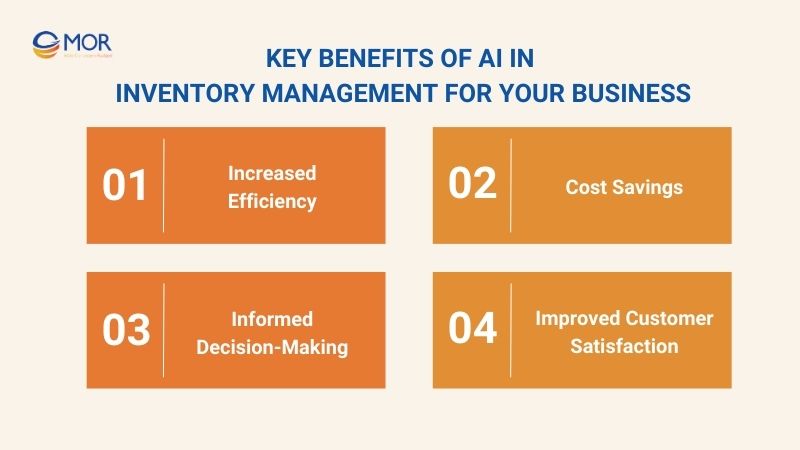
Increased Efficiency
Applying AI in inventory management automates replenishment processes, reducing order processing time and improving operational speed. AI automation systems analyze data from ERP, WMS, and POS to generate accurate demand forecasts and ensure warehouses maintain appropriate inventory levels.
Automated robots, such as those from Dexory, can scan up to 10,000 pallet locations per hour, digitizing warehouse inventory with unprecedented speed and accuracy. They capture physical inventory data and validate it against system records within seconds across the entire facility without disruption, significantly enhancing workflow efficiency and throughput.
Cost Savings
Accurate forecasting and automated replenishment through AI in inventory management help businesses reduce inventory holding costs, logistics expenses, and errors caused by manual data entry. For example, the system automatically adjusts stock levels based on actual demand, avoiding overstocking or unnecessary shipments.
AI-driven replenishment solutions optimize order quantities, minimize logistics costs, and improve working capital efficiency. As a result, businesses save budget, enhance cash flow, and strengthen their competitive advantage in the market.
Informed Decision-Making
AI provides real-time dashboards and analyzes sales trends, inventory, and SKU-level demand, enabling managers to make strategic decisions. This illustrates how AI is used in inventory management at a strategic level, rather than relying solely on experience or subjective estimates.
Businesses can plan distribution, adjust promotions, and optimize stock levels across warehouses and stores, reducing stockouts and increasing profitability. Data-driven decision-making enhances the overall efficiency of the supply chain and reduces the risks of poor decisions.
Improved Customer Satisfaction
AI accurately forecasts demand and automates replenishment, reducing stockouts and ensuring products are always available at stores or nearby warehouses. The use of AI in inventory management systems ensures timely deliveries, boosting customer satisfaction and Net Promoter Score (NPS).
For instance, Starbucks implemented an AI-powered inventory counting system at over 11,000 company-owned stores in North America. The system allows employees to scan shelves using handheld tablets, automatically counting products and alerting staff when items are low.
Practical Use Cases Of AI in Inventory Management To Improve Efficiency
The adoption of AI in inventory management goes beyond theory and delivers practical use cases that help businesses boost operational efficiency. Below are the specific applications that companies can implement to achieve measurable improvements.
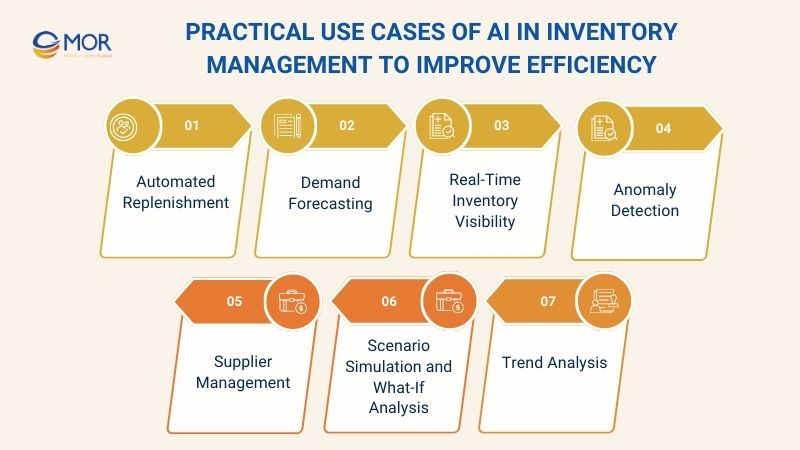
Automated Replenishment
In AI in inventory management, AI automation tools help businesses automate the entire restocking process. Instead of waiting for employees to manually detect low-stock items and create purchase orders, AI analyzes data from ERP, WMS, and POS to forecast demand, set reorder points, and automatically generate purchase orders.
Example: A retail supermarket chain with more than 200 stores implemented an automated replenishment system. When POS data recorded a spike in beer sales ahead of a holiday season:
Flow:
- POS captured the sales increase → data was sent to the AI system.
- AI compared current demand with available inventory and supplier lead time.
- If inventory approached the minimum threshold, AI automatically triggered a replenishment order, optimizing quantities based on holiday demand forecasts.
- The purchase order was sent directly to the supplier, while ERP/WMS was updated in real time.
Demand Forecasting
In AI in inventory management, demand forecasting plays a central role. Instead of relying only on historical sales, AI combines internal data (POS, ERP, WMS) with external factors such as weather, events, or market trends to deliver more accurate predictions.
Example: A beverage manufacturer applied AI-powered demand forecasting. When weather forecasts predicted a heatwave, the system increased demand projections for soft drinks in southern regions.
Flow:
- Weather data and POS sales were continuously collected by the system.
- The AI model analyzed correlations between temperature and beverage consumption.
- AI dynamically adjusted production and distribution plans by region.
Real-Time Inventory Visibility
Real-time inventory visibility allows businesses to minimize data discrepancies and achieve greater transparency across the supply chain. AI integrates IoT devices, WMS, and transportation data to provide a live, end-to-end view of stock levels both in warehouses and in-transit.
Example: An e-commerce company integrated AI with IoT sensors across warehouses and delivery trucks. The system allowed managers to track stock levels for every SKU in real time, synchronized with ERP.
Flow:
- IoT sensors recorded SKU quantities in warehouses and trucks.
- AI analyzed inventory data to identify which locations were at risk of stockouts.
- The system issued alerts and suggested internal stock transfers between warehouses.
Anomaly Detection
Inventory management often faces anomalies such as theft, data entry errors, or sudden demand spikes. AI in inventory management uses machine learning to perform anomaly detection, spotting irregularities in data and generating early alerts.
Example: A retailer detected that one store reported a fivefold increase in sales of product “A” in just one day. AI diversity flagged this as abnormal, leading to a review that confirmed a POS data entry error.
Flow:
- AI continuously monitored sales, inventory, and logistics data in real time.
- The model established a baseline of normal behavior based on historical records.
- When figures deviated beyond the threshold, the system flagged anomalies.
- Managers validated the alert and took corrective actions.
Supplier Management
Suppliers play a critical role in the supply chain, and risks like late deliveries or inconsistent quality can directly impact inventory. AI in inventory management analyzes historical data to evaluate supplier reliability and forecast risks.
Example: An electronics manufacturer used AI to analyze supplier delivery times and delay rates. The AI system identified one supplier with recurring late shipments over the last three months and recommended adjusting the sourcing strategy.
Flow:
- AI aggregated ERP data on orders, delivery times, and quality metrics.
- The system scored suppliers based on reliability.
- AI predicted potential risks of late deliveries in upcoming cycles.
- Managers adjusted procurement strategies or diversified suppliers to mitigate risks.
Scenario Simulation and What-If Analysis
Markets are dynamic, with disruptions ranging from supply chain crises to promotional surges. Generative AI in inventory management enables businesses to simulate scenarios and perform what-if analysis, preparing contingency plans in advance.
Example: An FMCG chain used generative AI agent frameworks to simulate a scenario where its primary supplier was disrupted for two weeks. The system recommended sourcing from secondary suppliers while redistributing stock across warehouses to maintain service levels.
Flow:
- Managers input hypothetical scenarios (e.g., 20% demand increase or 2-week delivery delay).
- Generative AI simulated the impact on inventory.
- The system proposed alternative strategies: switching suppliers, increasing safety stock, or reallocating goods.
- Businesses evaluated impacts and selected the most effective plan.
Trend Analysis
Every SKU has a lifecycle, seasonality, and unique consumption patterns. AI in inventory management conducts trend analysis to identify these patterns, helping businesses optimize stock levels accordingly.
Example: A fashion retailer applied AI to sales data and identified that wool coats experienced peak demand between October and December every year. The system recommended ramping up stock from September to capture early seasonal demand.
Flow:
- AI collected sales data and external market trends.
- The model analyzed SKU lifecycle, seasonality, and customer behavior.
- AI generated recommendations for increasing or reducing inventory by SKU.
- Managers adjusted purchasing, promotions, and distribution plans.
Challenges Of AI In Inventory Management For Modern Businesses
Implementing AI in inventory management brings significant opportunities but also presents notable challenges for modern businesses. Below are some of the key challenges that organizations must carefully evaluate before adoption.
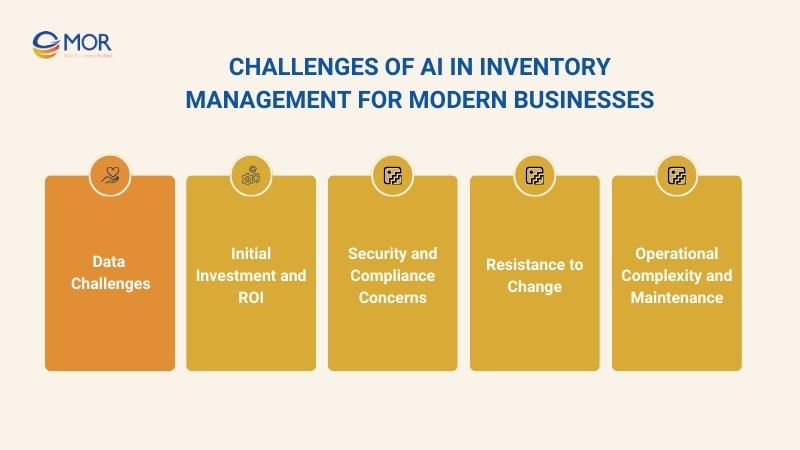
Data Challenges
In the process of implementing AI in inventory management, data remains the most critical foundation. However, many organizations face fragmented data across ERP, WMS, and POS systems, leading to the absence of a unified data source.
Another challenge lies in poor data quality: missing values, duplicate records, or inconsistent formatting between systems. These issues reduce the accuracy of AI models when performing demand forecasting or recommending replenishment actions.
Initial Investment and ROI
Deploying AI as a service often requires significant investment in software, data infrastructure, and employee training. This makes it difficult for organizations to determine ROI (Return on Investment) during the early stages.
A proven approach is to start with pilot projects on a limited set of SKUs or a single warehouse to measure tangible results.
Security and Compliance Concerns
When implementing AI in inventory management, companies must handle sensitive data such as customer information, product pricing, and stock levels. Without strong security measures, this data can be exposed, causing reputational damage and legal risks.
For example, a multinational distributor adopting distribution AI must comply with GDPR in Europe and CCPA in the U.S. This requires encryption, role-based access control (RBAC), and audit trails to ensure both security and transparency. Compliance with global data protection laws is essential to keep AI adoption safe, trustworthy, and legally sound.
Resistance to Change
One of the most overlooked barriers in adopting AI in inventory management is human resistance rather than technological limits. Employees may fear that AI or robots in warehouses will replace their jobs, or they may lack the skills to work with new systems.
Operational Complexity and Maintenance
AI is not a “set-and-forget” solution. Once deployed, AI models in inventory management are prone to model drift, where accuracy declines due to shifts in data or market behavior.
For instance, a retailer using the use of AI development services may notice that forecasts are accurate for the first six months, but gradually degrade as consumer trends change. Without proper retraining, the system risks generating poor replenishment decisions.
AI In Inventory Management Across Industries
The adoption of AI in inventory management not only brings overall benefits but also creates specific value for individual industries. Below is how AI in inventory management is applied across different sectors to optimize the supply chain and enhance operational efficiency.
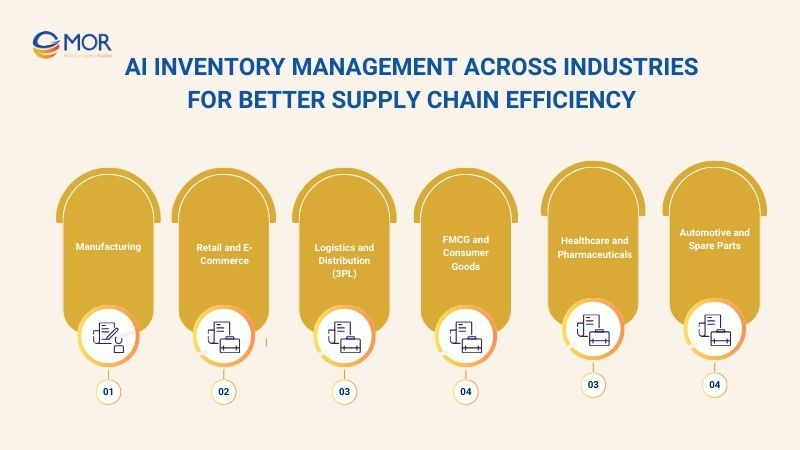
Manufacturing
AI in inventory management for manufacturing plays a critical role in optimizing material requirements planning (MRP), managing spare parts, and improving production scheduling. Instead of relying only on historical data, an AI in inventory management system integrates ERP, production line data, deep machine learning performance, and order history to generate more accurate demand forecasts.
Example: An automotive manufacturer deployed the use of AI in inventory management system combined with predictive maintenance.
Flow:
- IoT sensors capture machine performance and operating conditions.
- AI analyzes this data to detect potential breakdowns or declining productivity.
- The system automatically generates purchase orders for spare parts.
- ERP/WMS updates inventory status, while AI adjusts production schedules.
Retail and E-Commerce
In retail and e-commerce, AI in inventory management helps companies address complex challenges such as micro-fulfillment, omnichannel allocation, and out-of-stock prevention.
Example: A leading e-commerce platform in Southeast Asia leverages distribution AI to balance stock between regional warehouses. When electronics demand surges in Ho Chi Minh City, the system automatically recommends transferring stock from Hanoi to southern warehouses, ensuring fast delivery and preventing stockouts.
Flow:
- AI collects POS data and online customer behavior.
- The system forecasts demand by region and sales channel.
- AI recommends optimal allocation between warehouses and stores.
- The fulfillment system executes stock transfers or replenishment.
Logistics and Distribution (3PL)
For logistics providers and 3PL companies, AI in distribution deliver strong advantages in cross-docking, routing, and dynamic allocation. AI reduces warehouse dwell time, optimizes truck capacity utilization, and cuts distribution costs.
Example: A global 3PL provider uses AI to optimize cross-docking. When goods arrive from multiple suppliers, the AI inventory management system analyzes final destinations and assigns shipments to the most efficient truck routes automatically.
Flow:
- ERP/WMS provides order and destination data.
- AI analyzes routes, truck capacity, and delivery windows.
- AI dynamically groups shipments into optimized transport batches.
- Cross-docking operations forward goods directly without long storage.
FMCG and Consumer Goods
FMCG companies handle high-velocity SKUs, seasonal demand, and promotion-driven spikes. AI in inventory management enables dynamic stock planning, minimizes stockouts during peak seasons, and lowers carrying costs.
Example: A global FMCG brand applies AI to forecast confectionery demand during Lunar New Year. When the system detects a sharp rise in northern Vietnam, AI recommends building inventory from November and allocating additional stock to regional warehouses.
Flow:
- AI analyzes historical sales, promotion calendars, and consumer trends.
- The system forecasts SKU-specific demand across regions.
- AI recommends higher production and earlier distribution to key warehouses.
- Fulfillment systems execute replenishment in time for the holiday peak.
Healthcare and Pharmaceuticals
In healthcare and pharmaceuticals, inventory management is complex due to expiration dates, cold-chain logistics, and the critical importance of stock availability. Conversational AI in healthcare ensures lifecycle tracking, cold-chain optimization, and continuous access to essential medicines.
Example: A hospital chain implemented AI to track expiry dates of medicines and vaccines. When a batch of vaccines was found to be expiring within 30 days, AI recommended immediate reallocation to high-demand facilities, preventing wastage.
Flow:
- IoT sensors monitor expiry dates and cold storage conditions (temperature, humidity).
- AI identifies batches at risk of expiring soon.
- The system recommends internal transfers or urgent allocation.
- ERP/WMS updates stock levels and distribution records.
Automotive and Spare Parts
In the automotive industry, spare parts inventory is often long-tail (low turnover, sporadic demand) but still critical for service readiness. AI in inventory management forecasts demand for rare parts, optimizes inventory levels, and reduces holding costs.
Example: An automaker uses AI to forecast demand for rare parts like specialized gearboxes for older models. By analyzing repair histories, vehicle age distribution, and maintenance trends, the AI system determines optimal stock levels per region.
Flow:
- AI processes maintenance data, repair orders, and vehicle age profiles.
- The system forecasts demand for long-tail spare parts by region.
- AI optimizes reorder points to avoid shortages and overstock.
- ERP/WMS updates procurement and allocation plans.
Step-By-Step Guide To Implement AI In Inventory Management
Implementing AI in warehouse inventory management requires a clear roadmap to minimize risks and maximize efficiency. Below is a step-by-step guide detailing how to measure ROI for long-term supply chain optimization.
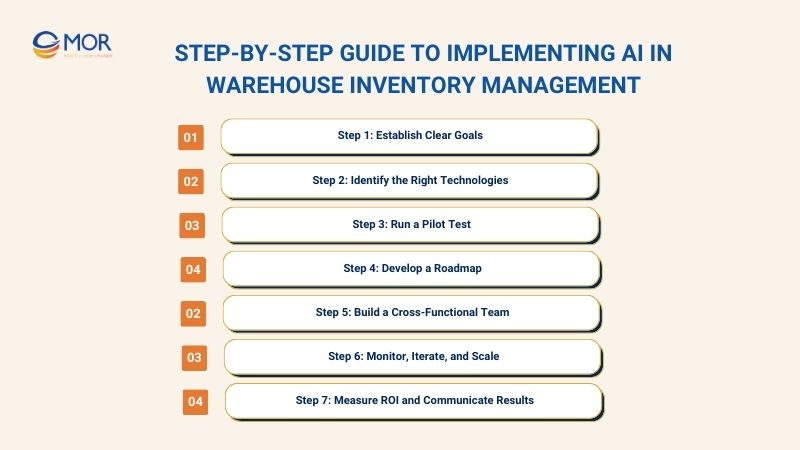
Step 1: Establish Clear Goals
To successfully implement AI in warehouse inventory management, businesses must define clear objectives and KPIs. This ensures the AI system has measurable targets and a clear foundation for training and evaluation. Key performance indicators often include:
- Service level targets to improve inventory availability.
- Forecast accuracy to reduce stockouts and overstock situations.
- Inventory turns to optimize storage efficiency.
- Total cost of ownership (TCO) to evaluate financial benefits.
Clear goals help ensure the AI system can be trained effectively, and performance can be measured accurately throughout the deployment process.
Step 2: Identify the Right Technologies
Selecting the right technology platform is a critical factor for successful AI in warehouse inventory management system deployment. Businesses should evaluate the strengths and weaknesses of on-premise and cloud solutions to ensure seamless integration and scalability.
Choosing the appropriate technology stack ensures the AI system will be efficient, adaptable, and future-proof.
Step 3: Run a Pilot Test
Pilot testing is essential to evaluate the feasibility of AI in warehouse inventory management before a full-scale rollout. Businesses should select a small group of SKUs or a regional warehouse for testing to reduce risks and validate the model. During the pilot:
- Gather live data from ERP/WMS and POS systems.
- Measure forecast accuracy and inventory turnover rates.
- Identify weaknesses and refine the AI model.
- Optimize data pipelines for future scaling.
Pilot testing also provides an initial ROI assessment, helping businesses decide on investment levels and the next steps for broader AI deployment.
Step 4: Develop a Roadmap
A detailed roadmap ensures a structured and efficient implementation of AI in warehouse inventory management. The deployment journey often spans 6 - 18 months, starting with the pilot, integrating with ERP/WMS, and culminating in a full rollout.
This roadmap helps align stakeholders and provides a clear plan for AI integration across the warehouse operation.
Step 5: Build a Cross-Functional Team
Implementing AI in warehouse inventory management requires more than just technology. It requires a cross-functional team that aligns people and processes. This team should include:
- Data engineers to manage data infrastructure.
- Data scientists to develop and refine AI models.
- Supply chain specialists to align AI outputs with inventory strategies.
- IT professionals to manage integrations and system stability.
- Operations staff to ensure practical execution.
Collaboration across these roles ensures the AI system is effectively deployed, integrated, and optimized for inventory management.
Step 6: Monitor, Iterate, and Scale
Post-deployment, continuous monitoring is vital to maintaining the performance of an AI in a warehouse inventory management system. Effective monitoring enables early detection of issues like model drift or forecast inaccuracies. This ensures the AI system adapts to evolving warehouse conditions and delivers sustained value.
Step 7: Measure ROI and Communicate Results
Measuring ROI is a critical final step in implementing AI in warehouse inventory management. Businesses should compare actual KPI performance against baselines to evaluate the AI system’s value. Steps include:
- Analyzing improvements in forecast accuracy, service levels, and inventory turns.
- Calculating cost savings and operational efficiency gains.
- Sharing quick wins and success stories internally.
- Adjusting strategies based on ROI insights.
Clear communication of results helps build trust and supports continuous improvement for future AI projects.
Custom AI In Inventory Management With MOR Software
Implementing AI in inventory management requires a reliable technology partner to ensure solutions are tailored to each business’s needs. MOR Software offers custom AI solutions designed to optimize inventory control, enhance supply chain efficiency, and reduce operational costs. Key reasons to choose MOR Software include:
- Global experience: Successfully delivering AI projects for markets in Japan, South Korea, Singapore, and US.
- Expert team: Skilled data scientists, developers, and supply chain specialists with deep expertise in inventory management and AI.
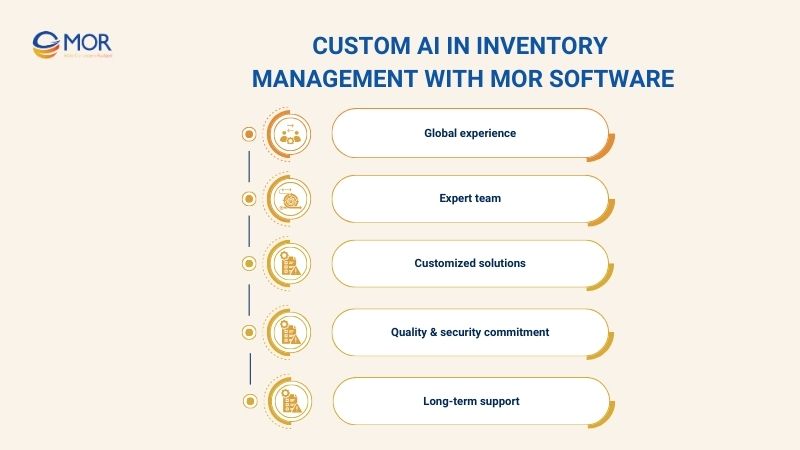
- Customized solutions: Building AI in warehouse inventory management systems tailored to specific requirements and seamlessly integrating with existing ERP/WMS.
- Quality & security commitment: ISO 9001:2015 and ISO/IEC 27001:2013 certified to ensure performance and data safety.
- Long-term support: Providing training, maintenance, and AI system upgrades to adapt to evolving business needs.
In Conclusion
In today’s competitive market, leveraging AI in inventory management is essential for maintaining efficiency and enhancing supply chain resilience. With MOR Software’s custom solutions, your business can achieve smarter inventory control and stronger operational performance. Contact MOR Software today to explore how tailored AI-driven strategies can revolutionize your inventory management.
MOR SOFTWARE
Frequently Asked Questions (FAQs)
How does Amazon use AI in inventory management?
Amazon uses AI to forecast demand, optimize stock levels, automate replenishment, and power warehouse robots for faster picking and packing.
Can AI count inventory?
Yes. AI can track and count inventory using IoT sensors, computer vision, and real-time data from warehouse management systems.
What software is best for inventory management?
It depends on business size and needs. Popular options include NetSuite, Odoo, SAP, Oracle, and custom AI-powered inventory systems.
What is generative AI in supply chain?
Generative AI creates simulations and what-if scenarios for demand, disruptions, and supplier risks, helping businesses plan more effectively.
How will AI change logistics?
AI will improve routing, automate warehouses, enhance real-time visibility, and reduce costs, making logistics faster and more reliable.
Rate this article
0
over 5.0 based on 0 reviews
Your rating on this news:
Name
*Email
*Write your comment
*Send your comment
1